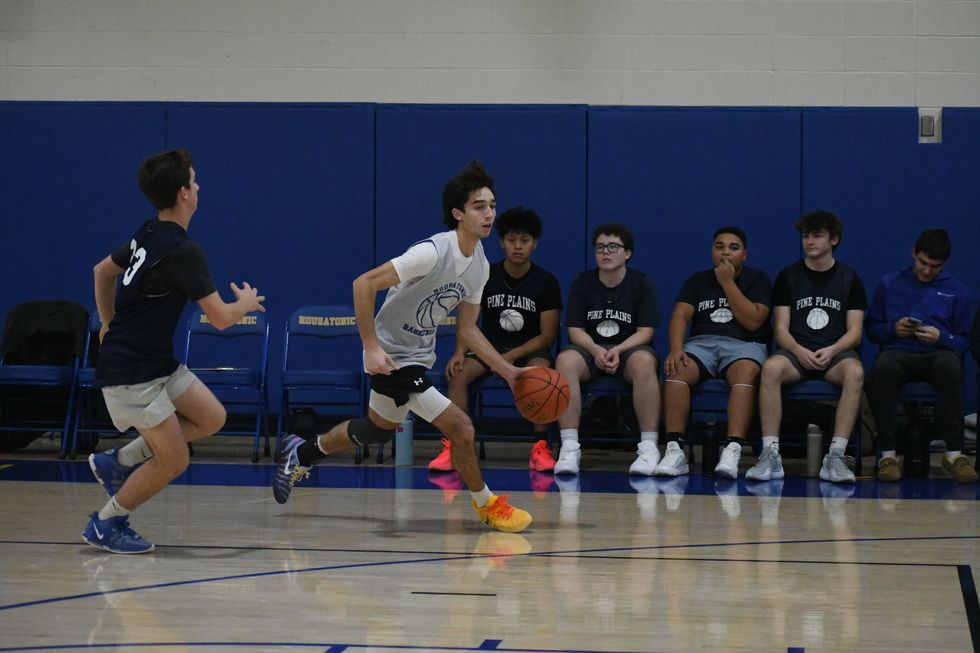Cornwall apple tree investigation bears fruit

Sally O'Connell with her young Burnham Sweet tree that she bought at the lecture May 3.
L. Tomaino

Sally O'Connell with her young Burnham Sweet tree that she bought at the lecture May 3.
CORNWALL — Attendees of Cornwall Library’s apple history talk Saturday, May 3, had the opportunity to take home a piece of town history.
The talk, titled “Discovering Cornwall’s Apple Heritage: Past, Present, and Future,” was given by three local apple detectives whose efforts successfully reproduced a heritage apple tree unique to town.
Peter Del Tredici, a horticulturist retired from Harvard where he worked in the Arnold Arboretum and the Harvard Forest, and Ian Ridgway and his father, Gordon, of Ridgway Farm, shared their findings before guests were able to buy the unique trees.
Inspired by a book titled “Uncultivated” by Andy Brennan, the Ridgways began searching Cornwall for old apple varieties, also called heritage apples, to grow and use in their future cidery.
Ian explained that in colonial times, “Cider was vital to survival,” since water was often nonpotable. Records indicate Cornwall, a town of about 1,500 people at the time, produced 1,500 barrels of cider in the year 1800.
In early America, apple varieties became localized to states and regions. Cornwall developed its own unique heritage apples over time.
In the 1880’s apple varieties from Europe began to be imported. This caused the market to be driven to specific varieties, ending the hyper-localized varieties.
Then, during Prohibition thousands of apple trees were cut down due to the alcohol content of hard cider, making the older varieties hard to find.
In the group’s search for Cornwall apple varieties, they have discovered “Baldwin’s, Maiden’s Blush, Esopus Spitzenburg, Fameuse, St. Lawrence and Transcendent Crabapple.”
Del Tredici said that DNA can’t be used to identify apples, since they are all hybrids made from grafting. Apples could have DNA from their root stock and from the scions — cuts from the growth of the tree — taken from other trees, resulting in no pure strain.
In Maine, more apples survived through Prohibition. John Bunker of Fedco Nursery, known as “the Sherlock Holmes of Maine apples,” began to hunt for the old varieties. He authored the book “Apples and the Art of Detection.”
“He’s an icon,” said Ian. If Ian, his father, or Del Tredici have an apple they can’t identify, they send it to Bunker.
A very old apple tree on Cream Hill had Del Tredici puzzled. The apple was bitter. “I was not impressed by it.” He noticed that it “had fruit very late in the fall and one year on Jan. 27 there were still apples falling from it.On Christmas of 2015, it still had apples.”
Even Bunker could not identify it. In 2020, Del Tredici took some scions to Bunker for propagation.
Referencing old books, such those by the American Pomological Society and the Connecticut Agricultural Board and old nursery catalogs, they began with location, Cornwall.
Examining the traits of the apple including color, size, productivity, flavor, and how long it keeps, they finally identified the tree as Burnham Sweet, named for Oliver Burnham, a revolutionary war soldier, who had lived on Rattlesnake Road.
T.S. Gold of West Cornwall propagated, introduced, and named the Burnham Sweet apple. It was recorded in 1869 at his farm.
The old tree is on its “last legs now” said Del Tredici. But it will now live on in the trees grafted by Bunker.
Twenty-seven young Burnham Sweet trees made the trip down from Maine.Five of them went to Ridgway Farm, one is to be planted at the Cornwall Historical Society. Others were sold after the lecture to benefit the Cornwall Library.
The Burnham Sweet’s return to Cornwall was welcomed.
The Salisbury Winter Sports Association (SWSA) will host its annual Junior Jump Camp, a two-day introduction to ski jumping, on Saturday and Sunday, Dec. 27 and 28, from 9 a.m. to 2 p.m. at Satre Hill in Salisbury.
The camp is open to children ages 7 and up and focuses on teaching the basics of ski jumping, with an emphasis on safety, balance and control, using SWSA’s smallest hill. No prior experience is required.
The cost is $50 per child and includes instruction and lunch on both days. For more information or to register, visit www.skireg.com/swsa-camp or email info@jumpfest.org
Jesse Bunce, first selectman of North Canaan.
LITCHFIELD — The Northwest Hills Council of Governments welcomed six newly elected municipal leaders Thursday, Dec. 11, at its first meeting following the 2025 municipal elections.
The council — a regional planning body representing 21 towns in northwest Connecticut — coordinates transportation, emergency planning, housing, economic development and other shared municipal services.
Barkhamsted First Selectman Meaghan Cook, Goshen First Selectman Seth Breakell, Kent First Selectman Eric Epstein, Norfolk First Selectman Henry Tirrell, North Canaan First Selectman Jesse Bunce and Torrington Mayor Molly Spino were each elected to their post in November.
They filled the seats of their predecessors on the COG, who were each given a toast of appreciation: Nick Lukiwsky (Barkhamsted), Todd Carusillo (Goshen), Marty Lindenmeyer (Kent), Matt Riiska (Norfolk), Brian Ohler (North Canaan) and Elinor Carbone (Torrington).
COG Executive Director Rob Phillips said the outgoing members were given a going away mug that read “You’re living the dream still.” Members voted to appoint Warren First Selectman Greg LaCava to fill a vacancy on the Council’s Executive Committee. COG members voted by paper ballot, and LaCava defeated Burlington First Selectman Doug Thompson for the vacant seat.
Ryan Segalla takes a fadeaway shot over a defender.
FALLS VILLAGE — Housatonic Valley Regional High School’s boys basketball team defeated Pine Plains High School 60-22 in a scrimmage Tuesday, Dec. 9. The non-league preseason game gave both sides an opportunity to run the court ahead of the 2025-26 varsity season.
HVRHS’s senior-heavy roster played with power and poise. The boys pulled ahead early and kept their foot on the gas through to the end.
By halftime the score was 33-8. Junior varsity players subbed in for the second half, but not before the starters got some in-game dunk practice. By the end Housatonic totaled 60 points to Pine Plains’ 22.

Nick Crodelle led the Mountaineers offensively with 13 points. Anthony Labbadia and Wyatt Bayer scored nine points each. Anthony Foley scored eight points. Owen Riemer and Ryan Segalla each scored seven points. Peyton Bushnell hit a three-pointer. Jaxon Visockis and Henry Berry each scored two points.
HVRHS begins Berkshire League competition on the road at Nonnewaug High School Tuesday, Dec. 16, with a 6 p.m. tip off.


Katie Moore delivers toys to the Stuff a Truck campaign held by the Kent Volunteer Fire Department last weekend. Donated toys are collected so that parents, who need some assistance, may provide their children with gifts this Christmas. Accepting the donation are elves Fran Goodsell and Karen Iannucci
KENT — Santa’s elves were toasty warm as they collected toys for the children of Kent.
Keeping with annual tradition, Fran Goodsell and Karen Iannucci manned the Stuff a Truck campaign sponsored by the Kent Volunteer Fire Department on Saturday, Dec. 6, and Sunday, Dec. 7. Sitting in front of a fire pit in the firehouse parking lot between donations from residents, they spoke of the incredible generosity displayed every season. That spirit of giving was clear from the piles of toys heaped on a table.
“This is always so gratifying,” said Goodsell, noting that certain businesses, including High Watch Recovery Center, Wilson’s, and Kent and South Kent schools needed a “shout out” for all they’ve done. She said South Kent School focuses on gifts for older children, which is a group that often is overlooked.
Unwrapped contributions are sought for children 1 to 15 years old who might otherwise find little or nothing from Santa, they said. The bounty will be set up at the Community House on Thursday, allowing parents to come and take what they want. If there are still items left, grandparents are invited to “shop.”
The atmosphere was festive Saturday, as a stuffed dog began barking a Christmas tune whenever someone walked in front of it. A large decked-out bear posted at the parking lot entrance reminded passersby of the event. Visiting children were able to get a close-up look at the fire truck and walk through the firehouse if they wished.
Goodsell and Iannucci were very grateful to those who donated wood for the fire pit. “And so many asked if they could bring us coffee or hot chocolate,” said Iannucci.
Goodsell said many who came talked about having grown children who were recipients of the gifts when their families were struggling. “They are so glad to be able to give back,” she said.